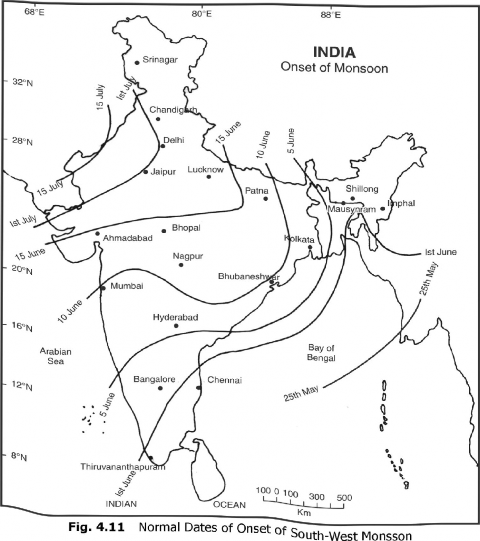Progress of the Monsoons
The normal date of the onset of the monsoon is towards the end of May in Sri Lanka and over Andaman and Nicobar Islands in the Bay of Bengal (Fig. 4.11). Thereafter, it bursts on the Malabar Coast in Kerala a week later by June 1, and the isolines on the onset chart display a pronounced curve over the Bay of Bengal. The subsequent progress of the monsoon in the country is divided by the tapering peninsula into two bifurcating currents, i.e. (i) the Bay of Bengal Current, and (ii) the Arabian Sea Current. The Arabian Sea branch gradually advances northwards reaching Mumbai by 10' June and Central India by 15th June.

In the meantime, the progress of the Bay of Bengal branch is no less spectacular. It moves northwards into the central Bay of Bengal and advances to nearly 20° N latitude in the Bay by the third week of May. It rapidly strikes the Arakan Coast and Chittagong Hills with full force, the direction being southwesterly, but the greatest force is felt in the angle between the east-west Meghalaya Plateau of the Khasi Hills and tire north-eastern Lushai Hills; Mizoram (Blue Mountains). Here Mawsynram to the west of Cherrapunji at an elevation of about 1313 metres receives nearly 1200 centimetres of rainfall annually. The Brahmaputra Valley is in the rainshadow of the Khasi Hills and receives less than 250 centimetres. The rainfall increases once again in the Himalayas, but the Bay of Bengal monsoon branch is deflected westwards due to the combined effect of the monsoon trough and the channelling by the Himalayas. As a consequence, its further progress is towards the Gangetic Plain of India, giving more rain to Himalayas and less in the plains. The arrival of the monsoon over Kolkata is 7th June, where, as mentioned earlier, the Arabian Sea branch of monsoon normally strikes Mumbai on 10th June. Both the branches of the monsoon current merge in the Gangetic Plain and gradually extend over Bihar, Jharkhand, Chhattisgarh, Uttar Pradesh, Uttarakhand, Haryana, Himachal Pradesh, Punjab, Jammu and Kashmir, and finally to Rajasthan, so that by the first week of July, i.e., within a mean interval of 29 days since the onset in Kerala, the south-west Monsoon is established all over India, excluding the Thar Desert. In the Thar Desert, the monsoon reaches by the middle of July, but only as a descending, drying wind, since by this time it has almost shed most of its moisture. It can be noted from Fig. 4.11 that for parts of the country west of 8()°E and south of 25°N, the advance of monsoon is from south to north, while in the rest of the country it is from south-east to north-west.
